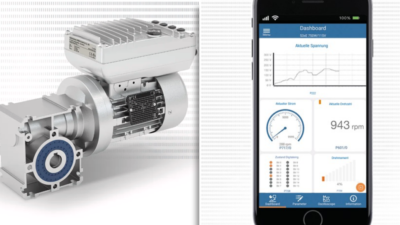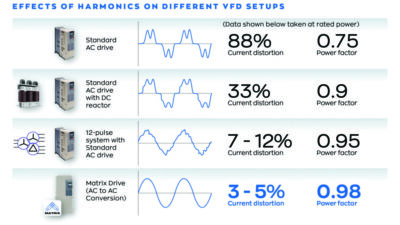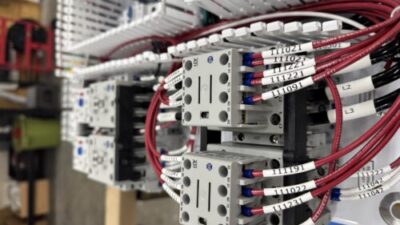Cost of energy to run many motors over their lifetimes is much more than the actual capital cost of the motors themselves. So if energy efficient motors cost so much less in the long run, why don't more people buy energy efficient motors? 1. They cost more upfront. 2. End-users may not realize or directly benefit from the lifecycle savings (capital cost of the motor plus energy cost to run the...
Sidebars: Motor sizing and efficiency resources
ONLINE EXTRA
Cost of energy to run many motors over their lifetimes is much more than the actual capital cost of the motors themselves. So if energy efficient motors cost so much less in the long run, why don’t more people buy energy efficient motors?
1. They cost more upfront.
2. End-users may not realize or directly benefit from the lifecycle savings (capital cost of the motor plus energy cost to run the motor). The person in charge of the capital budget for equipment may not be the same person in charge of energy usage. Minimizing capital expenditures to spend more on energy may be the equivalent of saving a dime and losing a dollar (or more in scale, saving a few thousand dollars now and losing tens of thousands of dollars over time or a few years). In some applications, electricity can cost 100 times the capital cost of the motor over its life, some sources say.
3. Those specifying the motors for use in machinery or equipment fear that customers won’t accept the slightly higher related capital costs involved and select a competitors’ design that costs less upfront, but much more over the equipments’ useful life. Various motor manufacturers, electric utilities, consultants, system integrators, savvy original equipment manufacturers (OEMs), policymakers, and legislators see opportunities to educate, encourage, and provide appropriate incentives for more energy efficient motor use. While that may be the most direct or obvious means of energy savings, it isn’t the only one.
Opportunities for savings
In a motion-based system, opportunities for efficiency include avoiding motion, using less motion, and kinetic energy recovery. Simply put, improving efficiency might mean:
Simplifying workflow to include fewer steps or handling something fewer times, so fewer motors are needed. Just-in-time initiatives can address that point.
Using variable speed drives that can run motors at a speed appropriate to an application, rather than wasting energy by running the motor a full speed and then wasting heat through gearboxes, braking, or damping to control speed.
New drive design: newer motor drives save energy using technologies that better manage voltage and power, optimizing onboard parameters to best-suit application needs. If the accompanying machine has water cooling, that also can be used to cool onboard motors and drives. Direct drive design is more efficient than a transmission.
Regeneration, often used on very large industrial motors, creates energy by using the motor as a generator to absorb kinetic energy, instead of dissipating energy by applying a brake.
Sizing changes. Engineers’ conservative tendencies may be to specify a motor and drive combination (or equipment in which they operate) one size larger. Doing so may waste electricity over time by running outside of the optimal band of efficiency for the actuator or the equipment in use.
U.S. Department of Energy says motor-driven equipment accounts for 64% of the electricity used in the U.S. industrial sector. Approximately 95% of an electric motor life cycle cost revolves around energy consumption, and those purchasing motors understand advantages of higher efficiencies. The U.S. National Electrical Manufacturers Association (NEMA) reported in 2004 that unit shipments of premium efficiency motors increased about 30% from 2001 to 2002, and another 14% from 2002 to 2003. NEMA continues to advocate for measures that encourage use of more energy efficient motors.
In May 2007 testimony to the U.S. House of Representatives’ Committee on Energy and Commerce’s Energy and Air Quality Subcommittee, NEMA president and CEO Evan Gaddis recommended that the Energy Policy and Conservation Act be further amended to give DOE authority to conduct an expedited rulemaking if submitted as a “consensus proposal.” The recent American Council for an Energy Efficient Economy (ACEEE)/NEMA consensus recommendations would accelerate the DOE timetable by three years to achieve savings for integral 1 hp to 200 hp motors as early as 2011, and would greatly increase the scope of federally-covered products.
In April, NEMA testified before the Senate Energy and Natural Resources Committee about pending legislation, S 1115, “The Energy Efficiency Promotion Act of 2007. NEMA “stressed the need for Congress to expand and extend energy-efficiency tax provisions as it shapes the overall legislative energy package” to remove “one of the barriers to deployment of today’s energy efficient products: their initial cost.” There’s “fierce competition for limited investment dollars,” NEMA says. And as more efficient motion technologies are used, more dollars will be freed for other investments.
Full-load motor efficiency (%)
Annual savings
Horsepower
Original efficiency
Final efficiency
Annual energy savings, kWh
Dollar savings, $/yr
Assumptions: 1,800 rpm enclosed fan-cooled motor with 8,760 hours per year of operation, 75% load, and an electricity rate of $0.05/kWh. Source : Control Engineering and industrial Technologies Program, Energy Efficiency and Renewable Energy, U.S. Department of Energy, www.eere.energy.gov/industry
10
89.5
90.5
605
$30
25
92.4
93.4
1,420
71
50
93.0
94.0
2,803
140
100
94.5
95.5
5,431
272
200
95.0
96.0
10,748
537
ONLINE EXTRA: Energy efficient motion products and resources
Click on the following to find or see some high efficiency motor and drive offerings from:
ABB
Baldor
Bosch Rexroth
Danfoss
Mitsubishi Electric Automation
Rockwell Automation
Schneider Electric
SEW Eurodrive
Siemens Energy & Automation
Yaskawa Electric
Find other high-efficiency motor manufacturers and distributors in the Control Engineering online buyer’s guide, CE Suppliersearch .
— High efficiency motors
— Variable speed drives
Other useful links for energy efficient industrial motion follow.
Comparative analysis of IEEE 112-B and IEC 34-2 efficiency testing standards
IEEE Find a standard
DOE estimate motor efficiency (PDF)
Senate Bill S 1115: “The Energy Efficiency Promotion Act of 2007″
Other energy efficient motion Control Engineering coverage includes:
NEMA call includes promotion of energy efficiency.
SPS/IPC/Drives 2006: Motion, mechatronics, efficiency
Silicon carbide (SiC) power module enable energy savings
Monitor induction motors to drive power quality
New technology boosts energy efficiency of single-phase motors
Energy-Efficient Motors Deliver Savings
In simplest terms, energy-efficient electric motors are high-quality versions of standard motor products. They pack more of “active” electric materials (steel laminations and copper) into essentially the same physical package—hence carry a price tag 15-30% higher than their less-efficient cousins…. Article includes summary of related laws, agreements, and standards.
Author Information
Mark T. Hoske is editor in chief of Control Engineering. Reach him at [email protected] .
Motor sizing and efficiency resources
MotorMaster+ Version 4.0.6 , released by U.S. Department of Energy (DOE) in March, updates the DOE’s Industrial Technology Program’s energy-efficient motor selection and management tool. The software includes a catalog of over 20,000 ac motors, along with motor inventory management tools, maintenance log tracking, efficiency analysis, savings evaluation, energy accounting, and environmental reporting capabilities. It has a checkbox to display only NEMA Premium motors in the MotorMaster+ List, addressing the requirement for federal government agencies to purchase only NEMA Premium motors. A similar option limits batch analysis setup to NEMA Premium for purchase of replacement motors. The version also updates motor price and performance data for Reliance, Baldor, and Siemens motors.
MotorMaster+ International 1.0.15 offers to evaluate repair / replacement options on a broader range of motors, including those tested under the Institute of Electrical and Electronic Engineers (IEEE) standard, and those tested using International Electrical Commission (IEC) methodology. Varied currencies and languages are available. Look under software tools at
NEMA Premium energy efficiency motors program aims to provide highly energy efficient products to meet the needs and applications of users and original equipment manufacturers (OEMs) based on a consensus definition. NEMA has been working with American Council for an Energy Efficient Economy (ACEEE) to advise Congress.
NEMA Premium energy efficiency specification free download.
ComponentSelector , a “motion-intelligent expert system” from MotionInfo.com and Incremotion Associates, helps optimize size, performance, and anticipated cost.
DOE Industrial Assessment Centers (IAC) Database is a collection of all the publicly available assessment and recommendation data. This includes information on the type of facility assessed (size, industry, energy usage, etc.) and details of resulting recommendations (type, energy & dollars savings etc.). As of May 2007, the IAC database contains: 13,453 assessments and 99,714 recommendations. Among recommendations, using energy efficient motors ranked 24th. Look under best practices at



